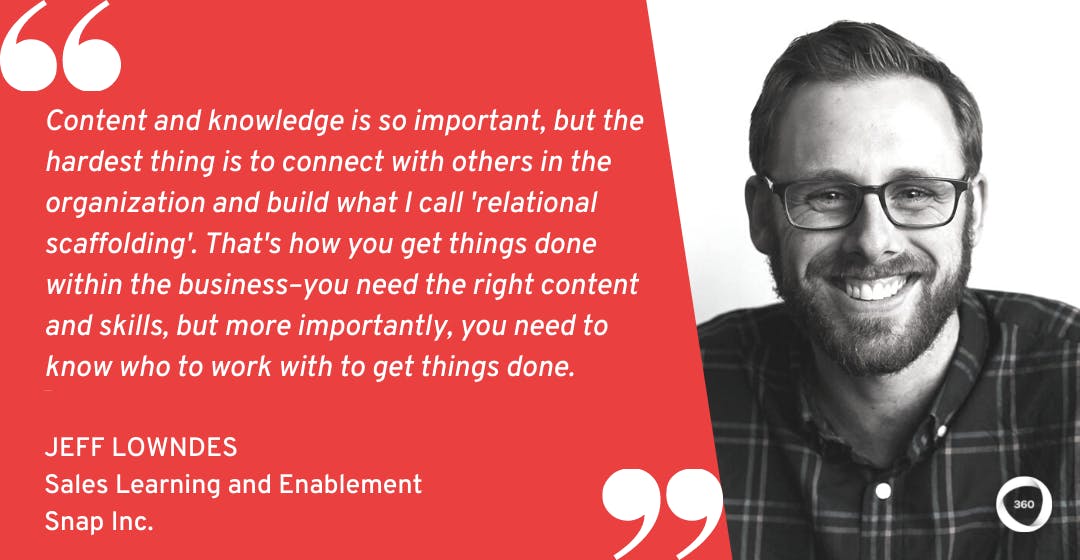
Snap’s 3 Techniques for Making New Sales Reps Feel Connected to Their Teams From Day One
Every new hire wants to make the biggest possible impact when they take on a new role. To do that, you need the right skills and technical knowledge. But more than that, you need to build close and trusted relationships with your new teammates.
So, how can sales enablement teams create the right onboarding programs to help new sales reps make these connections? How can you give them the support they need to build long-lasting relationships and hit the ground running?
Recently, I spoke with Jeff Lowndes of the Sales Learning and Enablement team at Snap Inc. Jeff oversees Snap’s global onboarding efforts for its sales reps, and it’s his job to create the right opportunities for these new hires to connect with others and thrive in their roles.
We got started by discussing the importance of relationships in quick-scaling companies.
Why building connections within the Snap sales team is so critical
According to Jeff, the camera and social media company Snap Inc. is scaling like crazy right now. Combined with COVID-19 and the pivot to remote working, this makes relationships between employees more important than ever.
“At Snap, we have about 700 people in our global sales organization, and we’re scaling and growing really fast,” says Jeff. “As we’re starting to come out of the COVID-19 pandemic, we’re in a more remote world than we ever were before. This creates some new challenges for us in terms of creating greater connection within the organization–especially for our sales reps.”
To meet this challenge and support Snap’s reps to make these connections, Jeff focuses on one thing overall: helping people build ‘relational scaffolding’.

For Jeff, this focus on building human connections isn’t just something he helps Snap’s sales reps with, either. When it comes to relationships, he also practices what he preaches.
“One thing I enjoy, and I’ve been told I’m fairly good at, is developing deep partnerships and relationships with stakeholders and cross-functional partners,” says Jeff. “I love getting work done, but I also just love getting to know people. That genuineness translates into being able to work really well with a lot of people and get things done.”
Related: 3 Biggest Challenges of Remote Sales Training and How to Overcome Them
Need a few more CLO Connect expert insights? Find out How L&D Can Help Your Company Scale
Snap’s 3 techniques for helping new sales reps build connections
So, relationships are critical for Snap’s new sales reps. But how does Jeff reflect this focus within his sales rep onboarding? And how does snap support people to build the strong bonds and human connections that will then translate into great working relationships?
“We’ve built a few different threads and lanes to support our new reps to develop the right relationships with people,” says Jeff. “We have a ten-week onboarding program overall, with a three-day experience that kicks it all off. The majority of the ten weeks is self-serve and managed at the team level. In part that’s due to us being a small team and not having the scale and resources to stay by the side of our new hires through the whole ten weeks.”
“It comes down to three elements: creating what we call ‘open spaces’, using a buddy system, and building dedicated communication channels.”
#1: Creating ‘open spaces’ for people to connect with each other
“Within our onboarding, especially the first three days, we create a lot of ‘open spaces’ for people to have the opportunity to connect with each other and start building relationships. We want them to have the chance to build relationships with leaders, but also with peers.”
For Jeff, these relationships aren’t just about helping new reps feel welcome–they’re also a key way to get things done once they finish ramping up. “I always tell our new hires, whenever we have a leader Q&A session, or whenever we’re completing a challenge activity where people are working together: ‘You’re going to get things done by working together with other people within the organization, so be intentional about building a network’.”
We create a lot of ‘open spaces’ for people to have the opportunity to connect with each other and start building relationships. We want them to have the chance to build relationships with leaders, but also with peers.
#2: Using a buddy system to build relationships
Like a lot of organizations, Snap uses a buddy system to give people a contact point on how things work within the organization, and where they can find the right information.
“Following this first three-day onboarding, we focus on building more and more elements to these relationships over time,” says Jeff. “We use a buddy system, which we’ve built out over time to include more people and more resources. We have great manager buy-in for this, which is why we’ve seen such strong results.”
#3: Building dedicated Slack channels for new sales hires
On top of creating these ‘open spaces’ and using a buddy system, Jeff also has some other techniques to support new reps to create relationships.
“We’re building other threads, such as ongoing Slack channels which are available for new hires where they have a space to ask questions,” says Jeff. “We’re teaching them how to reach out to cross-functional partners like us when they have questions.”
“Those are the major elements of how we support our new sales hires to build relationships and develop their personal networks.”
But how can Jeff be sure these three techniques are creating the right impact?
Related: The L&D Case for Peer Training: 3 Unignorable Reasons to Make the Switch
How to make sure you’re supporting reps to build relationships
As Jeff explains, measuring the impact of this support for relationship building is an ongoing effort. “We don’t have a silver bullet for measurement. We’re trying to find different data points in our organizational ecosystem that are indicators for whether we’re making the right impact.”
“One simple thing is, we run surveys once people have completed their onboarding, and we find out more about how people are interacting with the different phases of our onboarding. A lot of other teams will be familiar with this, because it’s such a fundamental and effective method.”
According to Jeff, these measurements are showing some very promising results so far. “Over the last few quarters, over 95% of people have said they feel either connected or very connected with our organization as a whole as a result of our onboarding program.”
“We ask that after we give people space to hear our leaders talk about Snap’s vision, and talk to peers about what it’s like to work at Snap. That’s a really positive data point for us.”
Over the last few quarters, over 95% of people have said they feel either connected or very connected with our organization as a whole as a result of our onboarding program.
But Snap’s measurement doesn’t just stop there. “We also use a lot of qualitative data, whether it’s through interviews or surveys, to check with people about how the buddy system is going. On top of that, we hold monthly water cooler sessions where we bring new hires and new hire alumni back together to chat not just about what’s working well in the business, but also about life in general. We’re seeing really positive sentiment as a result.”
In the future, Jeff is planning to expand this measurement even more. “We want to do more pulse surveys through the first 30, 60, and 90 days in order to gauge engagement and overall sentiment. Then, we can correlate our data between those who are engaging in the monthly water cooler sessions, and between those who are actively engaging in our buddy systems.”
“This way, we’ll be able to understand in greater detail whether these connections are leading to higher engagement.”
Related: 3 Data-Based Ways to Prove Training ROI (+ Free Training ROI Calculator)
Thanks again to Jeff for joining us to share his tips and advice!
While you’re here, check out my expert interviews with Ryan Giordano of Gong about using performance management to attract and motivate top talent, and with Jess Almlie of WEX about how to use Collaborative Learning to capture and replicate top sales behaviors.
Want more peer insights on transforming workplace learning? Check out #CLOConnect, our interview series with top L&D leaders on driving growth and scaling culture through Collaborative Learning. Or you can subscribe (below 👇) to our weekly newsletter to receive our latest posts directly in your inbox.


